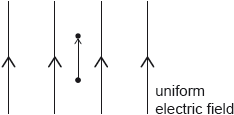| Date | May 2022 | Marks available | 2 | Reference code | 22M.2.HL.TZ1.7 |
| Level | Higher level | Paper | Paper 2 | Time zone | 1 |
| Command term | Identify | Question number | 7 | Adapted from | N/A |
Question
Two identical positive point charges X and Y are placed 0.30 m apart on a horizontal line. O is the point midway between X and Y. The charge on X and the charge on Y is +4.0 µC.
A positive charge Z is released from rest 0.010 m from O on the line between X and Y. Z then begins to oscillate about point O.
Calculate the electric potential at O.
Sketch, on the axes, the variation of the electric potential V with distance between X and Y.
Identify the direction of the resultant force acting on Z as it oscillates.
Deduce whether the motion of Z is simple harmonic.
Markscheme
use of ✓
OR 240 «kV» for one charge calculated ✓
480 «kV» for both ✓
MP1 can be seen or implied from calculation.
Allow ECF from MP2 for MP3.
symmetric curve around 0 with potential always positive, “bowl shape up” and curve not touching the horizontal axis. ✓
clear asymptotes at X and Y ✓
force is towards O ✓
always ✓
ALTERNATIVE 1
motion is not SHM ✓
«because SHM requires force proportional to r and» this force depends on ✓
ALTERNATIVE 2
motion is not SHM ✓
energy-distance «graph must be parabolic for SHM and this» graph is not parabolic ✓
Examiners report
This question was generally well approached. Two common errors were either starting with the wrong equation (electric potential energy or Coulomb's law) or subtracting the potentials rather than adding them.
Very few candidates drew a graph that was awarded two marks. Many had a generally correct shape, but common errors were drawing the graph touching the x-axis at O and drawing a general parabola with no clear asymptotes.
Many candidates were able to identify the direction of the force on the particle at position Z, but a common error was to miss that the question was about the direction as the particle was oscillating. Examiners were looking for a clear understanding that the force was always directed toward the equilibrium position, and not just at the moment shown in the diagram.
This was a challenging question for candidates. Most simply assumed that because the charge was oscillating that this meant the motion was simple harmonic. Some did recognize that it was not, and most of those candidates correctly identified that the relationship between force and displacement was an inverse square.



